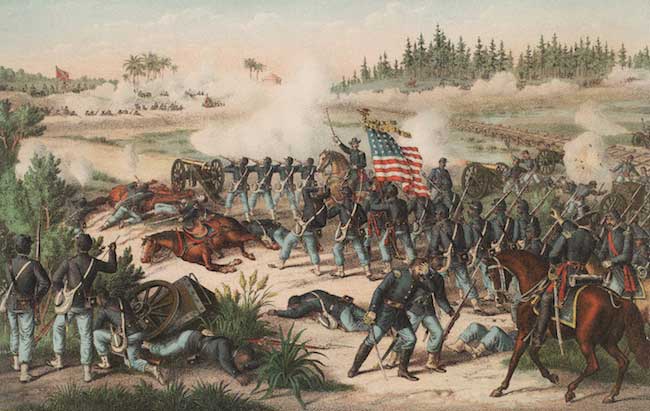On February 20th, history has been marked by a series of significant events that have influenced various aspects of global culture, politics, science, and society.
This article provides a chronological overview of 20 such events, showcasing the diversity and impact of human actions and achievements on this day.
From royal dowries that changed national borders to groundbreaking advancements in space exploration, each moment reflects the complex tapestry of human history and our continual quest for progress, understanding, and reflection on the world we inhabit.
February 20th Events in History
1472 – Orkney and Shetland are pawned by Norway to Scotland in lieu of a dowry for Margaret of Denmark
This event is a part of the marriage agreement between James III of Scotland and Margaret of Denmark. The dowry for Margaret was agreed upon as 60,000 Guilders.
However, Denmark was unable to pay the full amount, and as a compromise, the Orkney and Shetland islands, which were Norwegian territories at the time, were pawned to Scotland.
Also Read: February 19 – On this Day in History
This arrangement was meant to be temporary until the dowry was paid in full, but the payment was never made, and the islands remained under Scottish control thereafter, significantly altering the cultural landscape of these islands.
1547 – Edward VI is crowned King of England at just nine years old
Edward VI was the only son of Henry VIII and his third wife, Jane Seymour. Edward’s accession to the throne came after the death of his father in 1547.
Given his young age, Edward’s reign was dominated by regency councils. The first was led by his uncle, Edward Seymour, Duke of Somerset, and later by John Dudley, Duke of Northumberland.
Also Read: February 21st Events in History
Edward’s reign was marked by significant religious change, as his advisors were staunch Protestants who initiated reforms that moved England further from Roman Catholicism and established the Church of England’s foundations.

1792 – The Postal Service Act, establishing the United States Post Office Department, is signed by President George Washington
This act established the United States Post Office Department, a crucial development in the young nation’s infrastructure. The act made the postal service a permanent fixture of the government, with a Postmaster General appointed by the President.
This was an essential step in facilitating communication across the expanding territories of the United States, contributing significantly to its growth and cohesion.
1835 – Concepción, Chile is destroyed by an earthquake
The city of Concepción in Chile was hit by a powerful earthquake on February 20, 1835. This earthquake is one of the many significant seismic events that have affected Chile, a country located on the Pacific Ring of Fire and prone to earthquakes.
The 1835 quake devastated Concepción, leading to the city’s reconstruction in a new location nearby. This event was studied by Charles Darwin, who was in South America aboard the HMS Beagle at the time, and it contributed to his geological and natural observations.
1864 – Battle of Olustee occurs during the American Civil War; it is the largest battle fought in Florida
The Battle of Olustee, also known as the Battle of Ocean Pond, took place in Baker County, Florida. It was the largest battle fought in Florida during the American Civil War and involved around 5,000 Union troops and a similar number of Confederate soldiers.
The battle ended in a Confederate victory, significantly impacting Union plans to establish a stronger presence in Florida. The loss also hindered Union efforts to recruit former slaves and disrupt Confederate supply lines in the region.

1872 – The Metropolitan Museum of Art opens in New York City
The Metropolitan Museum of Art, often referred to as “the Met,” was founded in 1870 but officially opened its doors to the public on February 20, 1872.
Its initial location was at 681 Fifth Avenue. Today, the Met is one of the world’s largest and most prestigious art museums, housing a vast collection that spans 5,000 years of world culture, from prehistory to the present.
The museum’s mission has been to bring art and art education to the American people, a goal it has continuously expanded upon through its vast collections, exhibitions, and outreach programs.
1877 – Tchaikovsky’s ballet “Swan Lake” receives its premiere at the Bolshoi Theatre in Moscow
“Swan Lake,” composed by Pyotr Ilyich Tchaikovsky, is one of the most famous and enduring ballets worldwide. Its premiere at the Bolshoi Theatre was not initially deemed a success, partly due to the quality of the production and performance.
However, after Tchaikovsky’s death, a new version of “Swan Lake” choreographed by Marius Petipa and Lev Ivanov was presented in St. Petersburg in 1895, which became a huge success and is the basis for most modern productions. The ballet’s combination of drama, romance, and Tchaikovsky’s unforgettable music has ensured its place in the ballet repertoire.
1909 – Publication of the Futurist Manifesto in the French journal Le Figaro
The Futurist Manifesto, written by Italian poet Filippo Tommaso Marinetti, was published in Le Figaro, one of France’s leading newspapers. It was a provocative declaration of principles and intentions that inaugurated Futurism, an artistic and social movement.
The manifesto celebrated modernity, technology, and speed, advocating for the destruction of museums, libraries, and cultural norms of the past.
It aimed to rejuvenate Italian culture by embracing change and the energy of the 20th century. Futurism had a significant impact on art, inspiring related movements in painting, sculpture, music, and literature.
1943 – The Parícutin volcano begins to form in Parícutin, Mexico
The birth of the Parícutin volcano is one of the few instances in history where scientists and people could witness the formation of a new volcano. It began on February 20, 1943, in a farmer’s cornfield in Michoacán, western Mexico.
The eruption lasted for nine years, eventually covering 25 square kilometers with lava and standing about 424 meters tall. Parícutin is now an extinct volcano and part of the Michoacán-Guanajuato volcanic field. Its emergence provided valuable data for volcanologists and remains a significant case study in the study of volcanic activity.
1944 – World War II: The “Big Week” begins with American bomber raids on German aircraft manufacturing centers
The “Big Week,” also known as Operation Argument, was a series of massive daylight bombing raids carried out by the Allies from February 20 to 25, 1944.
The main targets were German aircraft production facilities, aiming to gain air superiority ahead of the planned invasion of Europe, Operation Overlord. The operation involved thousands of sorties by the U.S. Eighth Air Force and the Royal Air Force’s Bomber Command.
Despite heavy losses on both sides, the campaign significantly impaired Germany’s ability to produce aircraft, contributing to the Allies gaining air superiority over Europe.

1952 – Emmett Ashford becomes the first African American umpire in organized baseball by being authorized to be a substitute umpire in the Southwestern International League
Emmett Ashford broke racial barriers in American sports by becoming the first African American umpire in organized baseball. His journey began in the Southwestern International League, a minor league, where he was initially authorized as a substitute umpire.
Ashford’s charisma, distinctive umpiring style, and professionalism eventually led him to the Pacific Coast League and, notably, to Major League Baseball (MLB) in 1966.
Throughout his career, Ashford was known for his flamboyant call style and impeccable dress, making significant contributions to the game and paving the way for future generations of umpires of all races.
1959 – The Avro Arrow, Canada’s most advanced fighter aircraft at the time, is cancelled
The Avro Arrow (CF-105) was a delta-winged interceptor aircraft designed and built by Avro Canada. It was seen as a pinnacle of Canadian aerospace engineering achievement.
However, on February 20, 1959, the Canadian government abruptly cancelled the project due to escalating costs and changing defense priorities, influenced by the development of missile technology and the perception of manned fighter aircraft becoming obsolete.
The cancellation led to a significant loss of skilled workers, with many engineers and professionals leaving Canada for opportunities elsewhere, notably in the U.S. aerospace industry. The decision remains a controversial topic in Canadian history, symbolizing lost potential in Canadian innovation.
1962 – John Glenn becomes the first American to orbit the earth, making three orbits in Friendship 7
On this historic day, astronaut John Glenn orbited the Earth three times aboard the spacecraft Friendship 7, marking a significant milestone in the American space race with the Soviet Union.
Glenn’s mission, officially known as Mercury-Atlas 6, lasted nearly 5 hours and demonstrated the United States’ capability to send humans into orbit and return them safely to Earth.
This achievement was a critical step forward for NASA’s future manned space missions, including the Apollo moon landings. Glenn’s courage and the success of Friendship 7 galvanized the American public’s interest in space exploration and significantly contributed to the technological and scientific advancements in space travel.
1971 – The United States Emergency Broadcast System is accidentally activated in an erroneous national alert
On February 20, 1971, a false alarm of the United States Emergency Broadcast System (EBS) was transmitted across the country, causing confusion and concern.
The false alert was the result of a mistaken transmission of an emergency message instead of a scheduled test, leading broadcasters and the public to believe that a national emergency was underway.
The incident exposed vulnerabilities in the emergency alert system and led to changes in procedures to prevent future false alarms. This event remains a notable example of the challenges associated with managing national emergency communication systems.
1986 – The Soviet Union launches its Mir space station
The launch of the Mir space station by the Soviet Union marked a significant achievement in space exploration and the history of human habitation in space.
Mir, which means “peace” or “world” in Russian, was the first modular space station and served as a long-term research laboratory where astronauts and cosmonauts conducted scientific research in various fields such as astronomy, biology, and physics.
Over its lifetime, Mir hosted a large number of astronauts from different countries, including the United States, making it a symbol of international cooperation in space exploration. The space station was operational for over 15 years before being deorbited in 2001.
1998 – American figure skater Tara Lipinski becomes the youngest gold-medalist at the Winter Olympics in Nagano, Japan, at the age of 15
Tara Lipinski made history at the Nagano Winter Olympics by winning the gold medal in women’s figure skating, becoming the youngest individual gold medalist in the history of the Winter Olympic Games.
Her victory was a significant achievement, showcasing not only her exceptional technical skills but also her artistry and performance under pressure.
Lipinski’s win was particularly notable for her performance in the free skate, where she landed seven triple jumps, including a triple loop-triple loop combination, securing her place atop the podium and in Olympic history.
2003 – During the early stages of the Iraq war, a fire at the La Mesa Prison in Honduras kills 69 people
This tragic event occurred in the city of San Pedro Sula, at one of Honduras’ main prisons. The fire broke out during a period of intense conflict and unrest in the region. Initial reports suggested the fire was started intentionally during a riot within the facility.
The incident highlighted severe overcrowding and the dire conditions within the Honduran prison system, prompting calls for reform and investigation into the causes of such tragedies, as well as the overall treatment of inmates in the country’s penal institutions.
2005 – Spain becomes the first country to vote in a referendum on ratification of the proposed Constitution of the European Union
Spain’s referendum on the European Constitution was a landmark event in the EU’s history, signaling the start of a series of national votes across the member states. The Spanish electorate voted overwhelmingly in favor of the Constitution, which aimed at streamlining EU operations and enhancing its efficiency and coherence on the world stage.
However, the Constitution ultimately did not come into effect, as voters in France and the Netherlands rejected it later that year, leading to a period of reflection and the eventual drafting of the Lisbon Treaty as a substitute for the Constitution.
2008 – Fidel Castro retires as the President of Cuba after nearly fifty years
Fidel Castro’s resignation marked the end of an era in Cuban politics and world history. Having led the Cuban Revolution in 1959 and established a communist government, Castro was one of the longest-serving non-royal leaders of the 20th century.
His tenure was characterized by significant social reforms in Cuba as well as strained relations with the United States, including the infamous Bay of Pigs Invasion and the Cuban Missile Crisis. Castro’s retirement led to his brother, Raúl Castro, taking over the presidency, initiating a period of gradual economic and social reforms in Cuba.
2010 – The spacecraft Rosetta of the European Space Agency flies by the asteroid 21 Lutetia in a close approach of 3162 kilometers
The Rosetta spacecraft’s flyby of the asteroid 21 Lutetia was a significant milestone in its mission to study comets and asteroids, providing valuable data about the early solar system. Rosetta captured high-resolution images and gathered data on Lutetia’s size, composition, and morphology.
This encounter was part of Rosetta’s long journey to its primary target, Comet 67P/Churyumov-Gerasimenko, where it would later achieve the first-ever successful landing of a robotic probe on a comet.
The mission contributed greatly to our understanding of cometary and asteroid materials, shedding light on the building blocks of the solar system.
